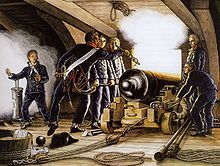Battery deck

On old warships, a battery deck is a deck on which cannons were placed. In the time of sailing ships was used muzzle-loading cannons in large numbers, by port- holes mentioned could fire in the ship's side to the side. In the first armed ships, cannons were only placed on the main deck. But soon the number of cannons was increased considerably, which then found their place on additional decks below the main deck, the battery decks.
Only the fully continuous battery decks were counted; the aft, forecastle and hut decks were not counted as "battery decks" since the cannons were not set up along the entire broadside . Exceptions here were the so-called spardecks, which were introduced on some frigates and later also on ships of the line and connected the aft and forecastle deck in the area of the Kuhl (the middle area of the upper deck) and thus created another continuous deck. These were counted as deck for ships of the line , but not for frigates.
Examples for this are:
- USS Constitution frigate (USA)
- Santissima Trinidad four-decker liner (Spain)
During the development of the frigate at the beginning of the 18th century, the first frigates were also equipped with two battery decks, but the lower one was usually only armed with 2 to 4 cannons. In the later frigates, this deck became the Berthdeck. Neither the previously armed nor the later unarmed deck were counted, even though they were full and continuous decks.
The largest sailing warships had three continuous battery decks with a total of up to 120 cannons. A ship of this type that still exists today is Admiral Nelsons Victory . The four-deckers with up to 136 cannons were much rarer; A savings deck was drawn in on these ships, but with regard to the hull construction they were three-deckers.
With the further development of ship artillery at the end of the 19th century, the cannons were no longer set up in broadsides and the number of battery decks lost their importance until this way of looking at and constructing a warship was completely abandoned.
